Analyzing UK-Japan Business Communication: A Case Study Approach
VerifiedAdded on 2023/06/13
|11
|2182
|70
Case Study
AI Summary
This case study examines the failed business negotiations between a UK executive and a Japanese company, attributing the failure to significant cultural differences. It highlights the importance of understanding Japanese national, organizational, and professional cultural aspects, including perseverance, power dynamics, and communication norms. The analysis utilizes the concept of self-construal to explain the differing perspectives and behaviors of the UK and Japanese professionals. Hofstede's cultural dimensions, such as power distance, individualism, and uncertainty avoidance, are applied to compare the cultures of the UK and Japan, providing further insights into the communication breakdown. The report advises adopting intercultural communication theories like communication accommodation theory and uncertainty management theory to improve future interactions. Ultimately, the study emphasizes the need for a deep understanding of different cultures to facilitate effective intercultural communication and avoid actions that may cause offense.

Project 1:
Case study
Case study
Paraphrase This Document
Need a fresh take? Get an instant paraphrase of this document with our AI Paraphraser
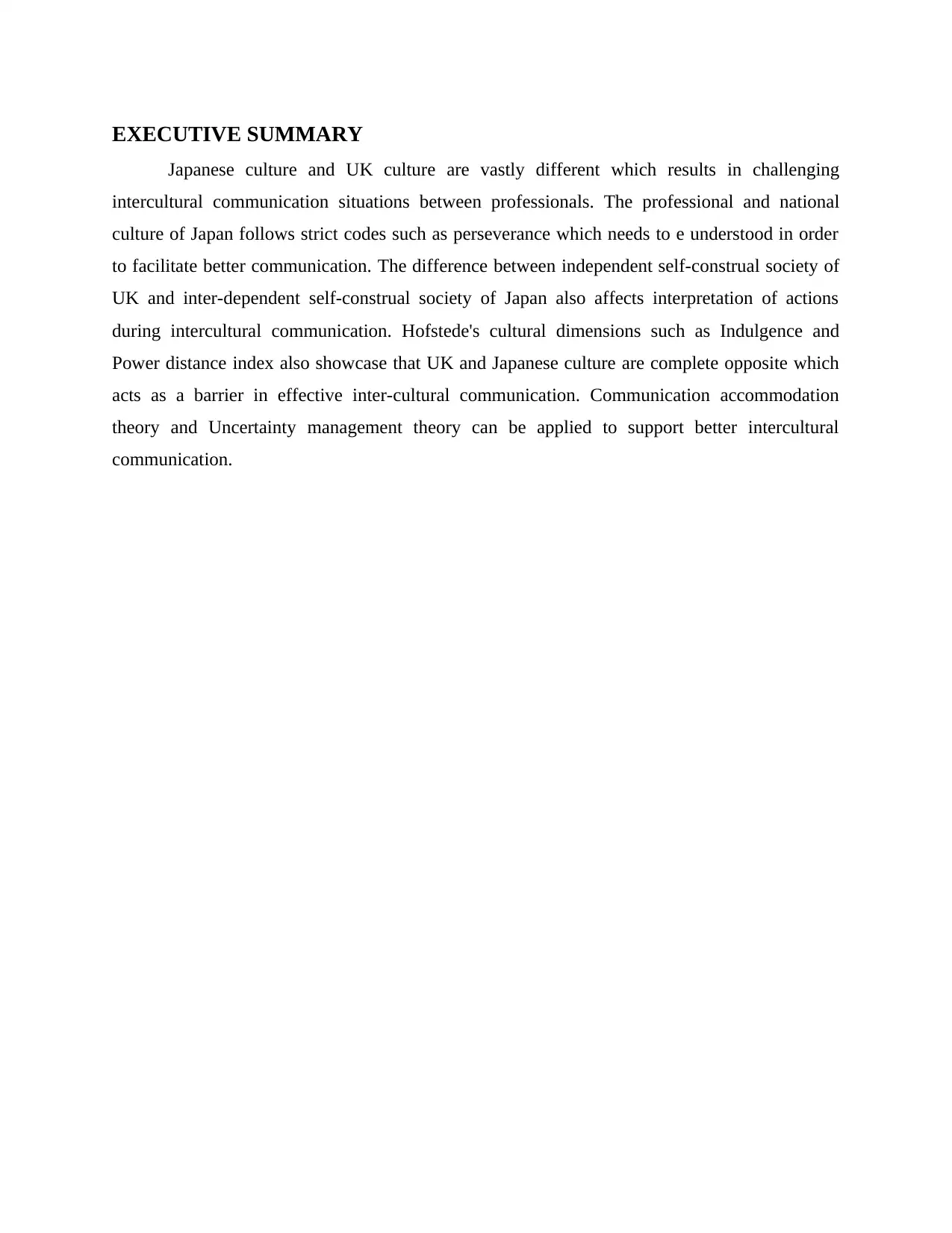
EXECUTIVE SUMMARY
Japanese culture and UK culture are vastly different which results in challenging
intercultural communication situations between professionals. The professional and national
culture of Japan follows strict codes such as perseverance which needs to e understood in order
to facilitate better communication. The difference between independent self-construal society of
UK and inter-dependent self-construal society of Japan also affects interpretation of actions
during intercultural communication. Hofstede's cultural dimensions such as Indulgence and
Power distance index also showcase that UK and Japanese culture are complete opposite which
acts as a barrier in effective inter-cultural communication. Communication accommodation
theory and Uncertainty management theory can be applied to support better intercultural
communication.
Japanese culture and UK culture are vastly different which results in challenging
intercultural communication situations between professionals. The professional and national
culture of Japan follows strict codes such as perseverance which needs to e understood in order
to facilitate better communication. The difference between independent self-construal society of
UK and inter-dependent self-construal society of Japan also affects interpretation of actions
during intercultural communication. Hofstede's cultural dimensions such as Indulgence and
Power distance index also showcase that UK and Japanese culture are complete opposite which
acts as a barrier in effective inter-cultural communication. Communication accommodation
theory and Uncertainty management theory can be applied to support better intercultural
communication.
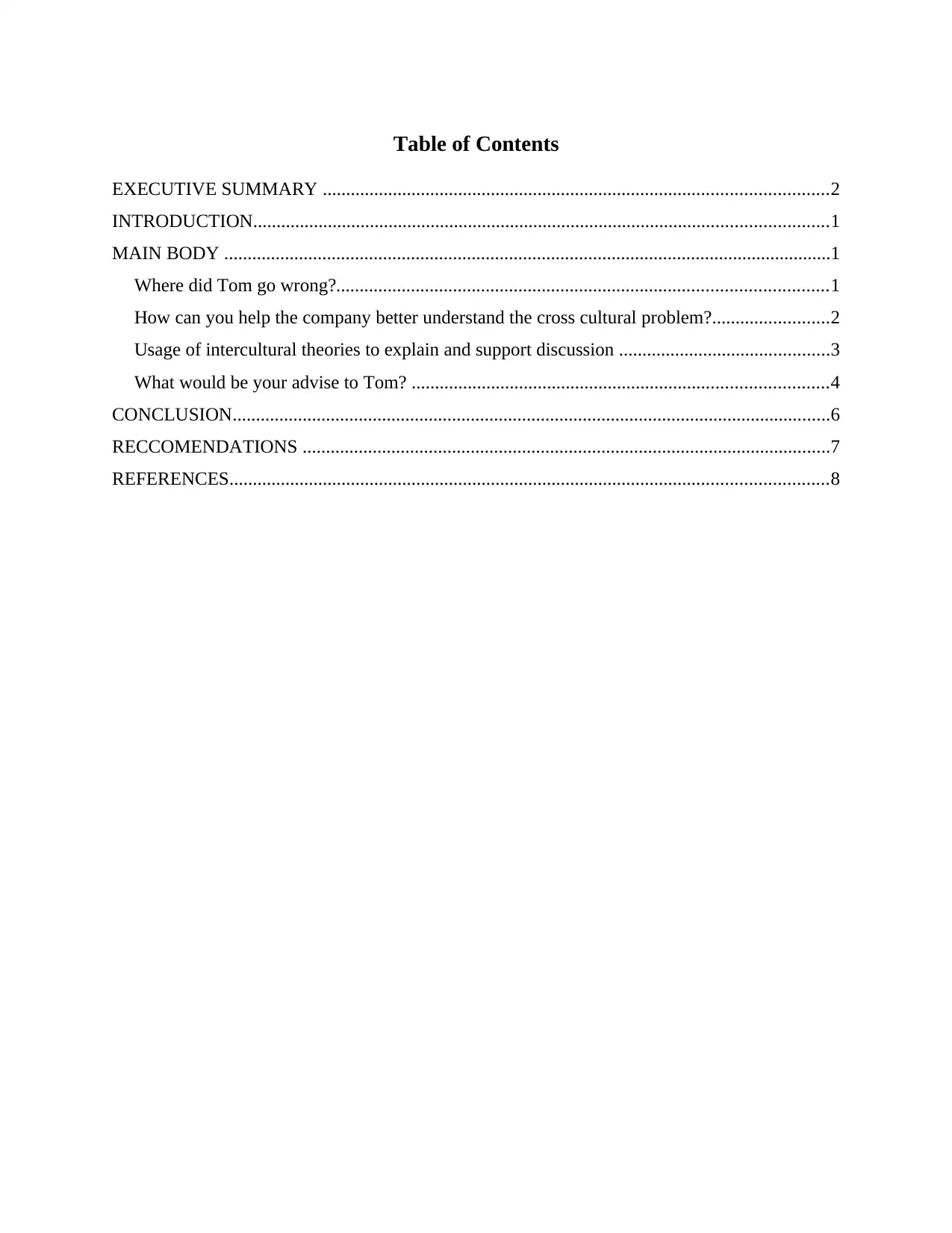
Table of Contents
EXECUTIVE SUMMARY ............................................................................................................2
INTRODUCTION...........................................................................................................................1
MAIN BODY ..................................................................................................................................1
Where did Tom go wrong?.........................................................................................................1
How can you help the company better understand the cross cultural problem?.........................2
Usage of intercultural theories to explain and support discussion .............................................3
What would be your advise to Tom? .........................................................................................4
CONCLUSION................................................................................................................................6
RECCOMENDATIONS .................................................................................................................7
REFERENCES................................................................................................................................8
EXECUTIVE SUMMARY ............................................................................................................2
INTRODUCTION...........................................................................................................................1
MAIN BODY ..................................................................................................................................1
Where did Tom go wrong?.........................................................................................................1
How can you help the company better understand the cross cultural problem?.........................2
Usage of intercultural theories to explain and support discussion .............................................3
What would be your advise to Tom? .........................................................................................4
CONCLUSION................................................................................................................................6
RECCOMENDATIONS .................................................................................................................7
REFERENCES................................................................................................................................8
⊘ This is a preview!⊘
Do you want full access?
Subscribe today to unlock all pages.

Trusted by 1+ million students worldwide
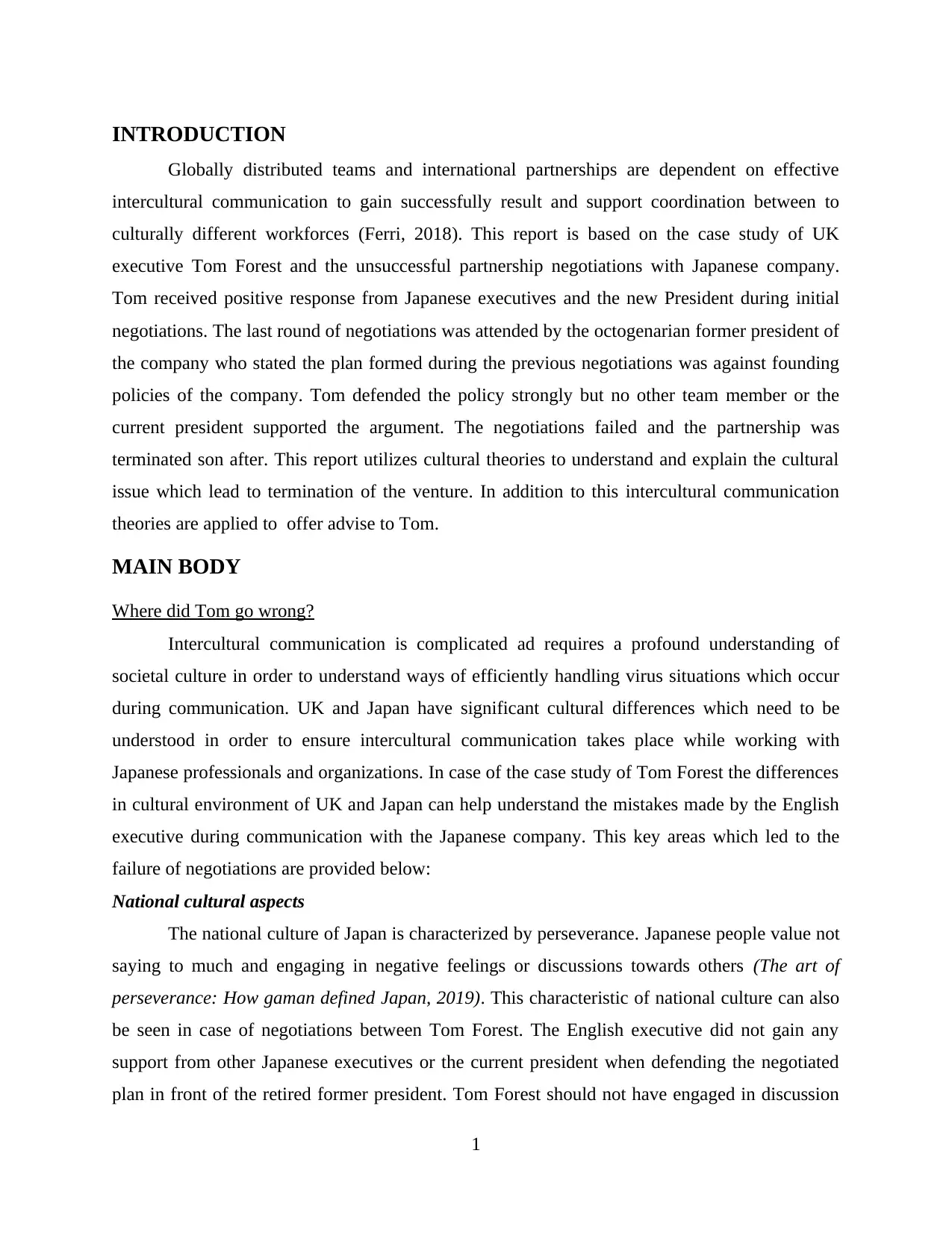
INTRODUCTION
Globally distributed teams and international partnerships are dependent on effective
intercultural communication to gain successfully result and support coordination between to
culturally different workforces (Ferri, 2018). This report is based on the case study of UK
executive Tom Forest and the unsuccessful partnership negotiations with Japanese company.
Tom received positive response from Japanese executives and the new President during initial
negotiations. The last round of negotiations was attended by the octogenarian former president of
the company who stated the plan formed during the previous negotiations was against founding
policies of the company. Tom defended the policy strongly but no other team member or the
current president supported the argument. The negotiations failed and the partnership was
terminated son after. This report utilizes cultural theories to understand and explain the cultural
issue which lead to termination of the venture. In addition to this intercultural communication
theories are applied to offer advise to Tom.
MAIN BODY
Where did Tom go wrong?
Intercultural communication is complicated ad requires a profound understanding of
societal culture in order to understand ways of efficiently handling virus situations which occur
during communication. UK and Japan have significant cultural differences which need to be
understood in order to ensure intercultural communication takes place while working with
Japanese professionals and organizations. In case of the case study of Tom Forest the differences
in cultural environment of UK and Japan can help understand the mistakes made by the English
executive during communication with the Japanese company. This key areas which led to the
failure of negotiations are provided below:
National cultural aspects
The national culture of Japan is characterized by perseverance. Japanese people value not
saying to much and engaging in negative feelings or discussions towards others (The art of
perseverance: How gaman defined Japan, 2019). This characteristic of national culture can also
be seen in case of negotiations between Tom Forest. The English executive did not gain any
support from other Japanese executives or the current president when defending the negotiated
plan in front of the retired former president. Tom Forest should not have engaged in discussion
1
Globally distributed teams and international partnerships are dependent on effective
intercultural communication to gain successfully result and support coordination between to
culturally different workforces (Ferri, 2018). This report is based on the case study of UK
executive Tom Forest and the unsuccessful partnership negotiations with Japanese company.
Tom received positive response from Japanese executives and the new President during initial
negotiations. The last round of negotiations was attended by the octogenarian former president of
the company who stated the plan formed during the previous negotiations was against founding
policies of the company. Tom defended the policy strongly but no other team member or the
current president supported the argument. The negotiations failed and the partnership was
terminated son after. This report utilizes cultural theories to understand and explain the cultural
issue which lead to termination of the venture. In addition to this intercultural communication
theories are applied to offer advise to Tom.
MAIN BODY
Where did Tom go wrong?
Intercultural communication is complicated ad requires a profound understanding of
societal culture in order to understand ways of efficiently handling virus situations which occur
during communication. UK and Japan have significant cultural differences which need to be
understood in order to ensure intercultural communication takes place while working with
Japanese professionals and organizations. In case of the case study of Tom Forest the differences
in cultural environment of UK and Japan can help understand the mistakes made by the English
executive during communication with the Japanese company. This key areas which led to the
failure of negotiations are provided below:
National cultural aspects
The national culture of Japan is characterized by perseverance. Japanese people value not
saying to much and engaging in negative feelings or discussions towards others (The art of
perseverance: How gaman defined Japan, 2019). This characteristic of national culture can also
be seen in case of negotiations between Tom Forest. The English executive did not gain any
support from other Japanese executives or the current president when defending the negotiated
plan in front of the retired former president. Tom Forest should not have engaged in discussion
1
Paraphrase This Document
Need a fresh take? Get an instant paraphrase of this document with our AI Paraphraser
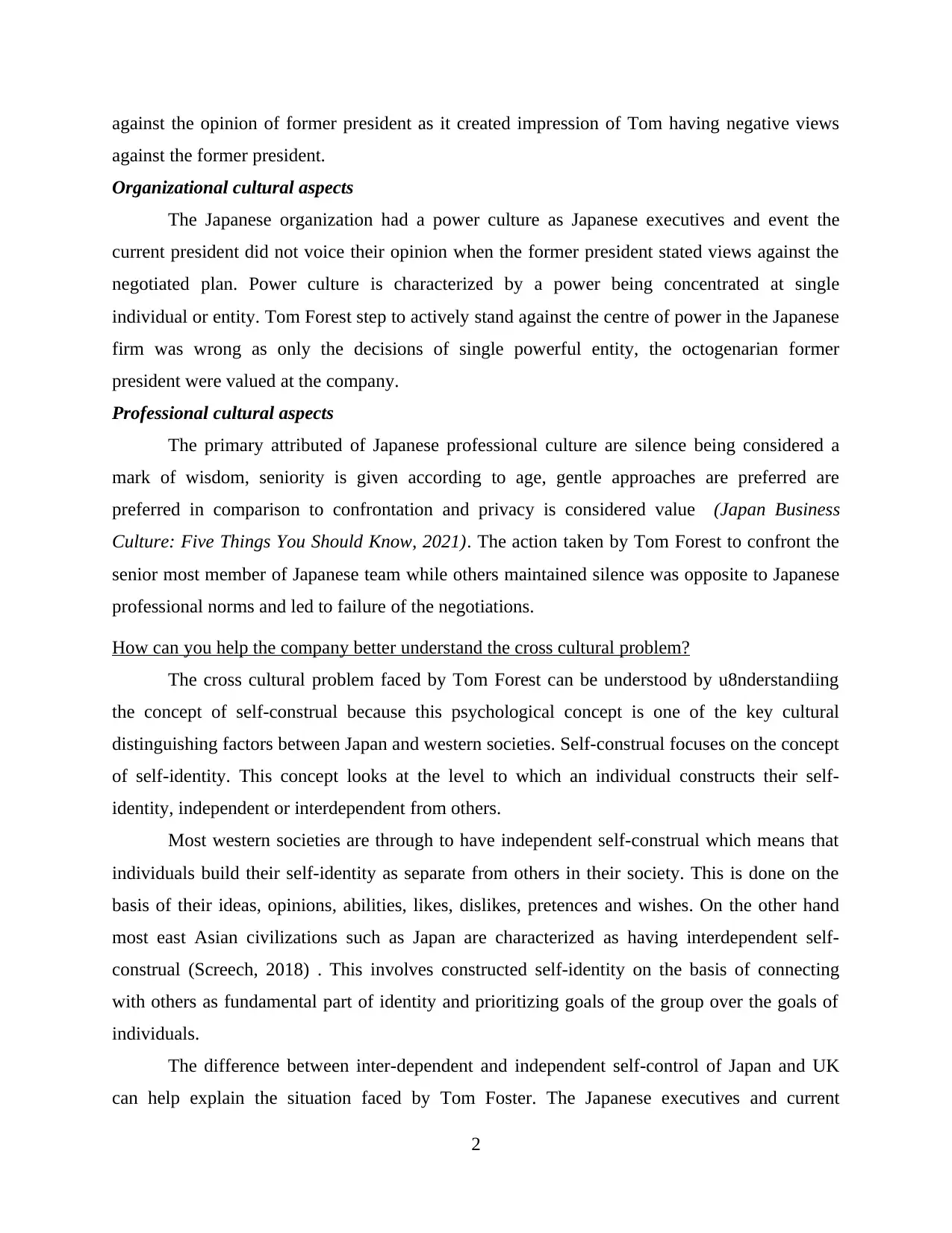
against the opinion of former president as it created impression of Tom having negative views
against the former president.
Organizational cultural aspects
The Japanese organization had a power culture as Japanese executives and event the
current president did not voice their opinion when the former president stated views against the
negotiated plan. Power culture is characterized by a power being concentrated at single
individual or entity. Tom Forest step to actively stand against the centre of power in the Japanese
firm was wrong as only the decisions of single powerful entity, the octogenarian former
president were valued at the company.
Professional cultural aspects
The primary attributed of Japanese professional culture are silence being considered a
mark of wisdom, seniority is given according to age, gentle approaches are preferred are
preferred in comparison to confrontation and privacy is considered value (Japan Business
Culture: Five Things You Should Know, 2021). The action taken by Tom Forest to confront the
senior most member of Japanese team while others maintained silence was opposite to Japanese
professional norms and led to failure of the negotiations.
How can you help the company better understand the cross cultural problem?
The cross cultural problem faced by Tom Forest can be understood by u8nderstandiing
the concept of self-construal because this psychological concept is one of the key cultural
distinguishing factors between Japan and western societies. Self-construal focuses on the concept
of self-identity. This concept looks at the level to which an individual constructs their self-
identity, independent or interdependent from others.
Most western societies are through to have independent self-construal which means that
individuals build their self-identity as separate from others in their society. This is done on the
basis of their ideas, opinions, abilities, likes, dislikes, pretences and wishes. On the other hand
most east Asian civilizations such as Japan are characterized as having interdependent self-
construal (Screech, 2018) . This involves constructed self-identity on the basis of connecting
with others as fundamental part of identity and prioritizing goals of the group over the goals of
individuals.
The difference between inter-dependent and independent self-control of Japan and UK
can help explain the situation faced by Tom Foster. The Japanese executives and current
2
against the former president.
Organizational cultural aspects
The Japanese organization had a power culture as Japanese executives and event the
current president did not voice their opinion when the former president stated views against the
negotiated plan. Power culture is characterized by a power being concentrated at single
individual or entity. Tom Forest step to actively stand against the centre of power in the Japanese
firm was wrong as only the decisions of single powerful entity, the octogenarian former
president were valued at the company.
Professional cultural aspects
The primary attributed of Japanese professional culture are silence being considered a
mark of wisdom, seniority is given according to age, gentle approaches are preferred are
preferred in comparison to confrontation and privacy is considered value (Japan Business
Culture: Five Things You Should Know, 2021). The action taken by Tom Forest to confront the
senior most member of Japanese team while others maintained silence was opposite to Japanese
professional norms and led to failure of the negotiations.
How can you help the company better understand the cross cultural problem?
The cross cultural problem faced by Tom Forest can be understood by u8nderstandiing
the concept of self-construal because this psychological concept is one of the key cultural
distinguishing factors between Japan and western societies. Self-construal focuses on the concept
of self-identity. This concept looks at the level to which an individual constructs their self-
identity, independent or interdependent from others.
Most western societies are through to have independent self-construal which means that
individuals build their self-identity as separate from others in their society. This is done on the
basis of their ideas, opinions, abilities, likes, dislikes, pretences and wishes. On the other hand
most east Asian civilizations such as Japan are characterized as having interdependent self-
construal (Screech, 2018) . This involves constructed self-identity on the basis of connecting
with others as fundamental part of identity and prioritizing goals of the group over the goals of
individuals.
The difference between inter-dependent and independent self-control of Japan and UK
can help explain the situation faced by Tom Foster. The Japanese executives and current
2
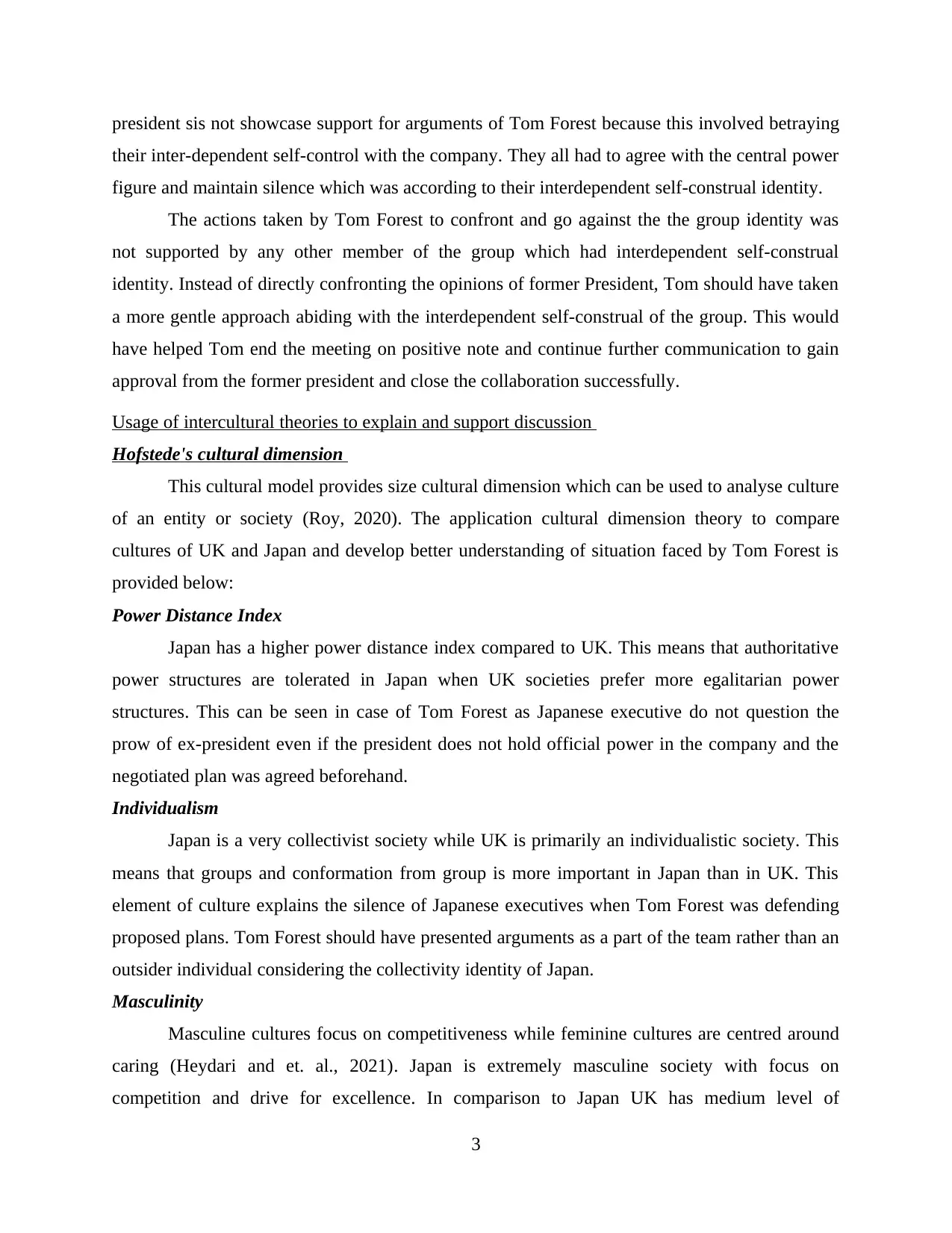
president sis not showcase support for arguments of Tom Forest because this involved betraying
their inter-dependent self-control with the company. They all had to agree with the central power
figure and maintain silence which was according to their interdependent self-construal identity.
The actions taken by Tom Forest to confront and go against the the group identity was
not supported by any other member of the group which had interdependent self-construal
identity. Instead of directly confronting the opinions of former President, Tom should have taken
a more gentle approach abiding with the interdependent self-construal of the group. This would
have helped Tom end the meeting on positive note and continue further communication to gain
approval from the former president and close the collaboration successfully.
Usage of intercultural theories to explain and support discussion
Hofstede's cultural dimension
This cultural model provides size cultural dimension which can be used to analyse culture
of an entity or society (Roy, 2020). The application cultural dimension theory to compare
cultures of UK and Japan and develop better understanding of situation faced by Tom Forest is
provided below:
Power Distance Index
Japan has a higher power distance index compared to UK. This means that authoritative
power structures are tolerated in Japan when UK societies prefer more egalitarian power
structures. This can be seen in case of Tom Forest as Japanese executive do not question the
prow of ex-president even if the president does not hold official power in the company and the
negotiated plan was agreed beforehand.
Individualism
Japan is a very collectivist society while UK is primarily an individualistic society. This
means that groups and conformation from group is more important in Japan than in UK. This
element of culture explains the silence of Japanese executives when Tom Forest was defending
proposed plans. Tom Forest should have presented arguments as a part of the team rather than an
outsider individual considering the collectivity identity of Japan.
Masculinity
Masculine cultures focus on competitiveness while feminine cultures are centred around
caring (Heydari and et. al., 2021). Japan is extremely masculine society with focus on
competition and drive for excellence. In comparison to Japan UK has medium level of
3
their inter-dependent self-control with the company. They all had to agree with the central power
figure and maintain silence which was according to their interdependent self-construal identity.
The actions taken by Tom Forest to confront and go against the the group identity was
not supported by any other member of the group which had interdependent self-construal
identity. Instead of directly confronting the opinions of former President, Tom should have taken
a more gentle approach abiding with the interdependent self-construal of the group. This would
have helped Tom end the meeting on positive note and continue further communication to gain
approval from the former president and close the collaboration successfully.
Usage of intercultural theories to explain and support discussion
Hofstede's cultural dimension
This cultural model provides size cultural dimension which can be used to analyse culture
of an entity or society (Roy, 2020). The application cultural dimension theory to compare
cultures of UK and Japan and develop better understanding of situation faced by Tom Forest is
provided below:
Power Distance Index
Japan has a higher power distance index compared to UK. This means that authoritative
power structures are tolerated in Japan when UK societies prefer more egalitarian power
structures. This can be seen in case of Tom Forest as Japanese executive do not question the
prow of ex-president even if the president does not hold official power in the company and the
negotiated plan was agreed beforehand.
Individualism
Japan is a very collectivist society while UK is primarily an individualistic society. This
means that groups and conformation from group is more important in Japan than in UK. This
element of culture explains the silence of Japanese executives when Tom Forest was defending
proposed plans. Tom Forest should have presented arguments as a part of the team rather than an
outsider individual considering the collectivity identity of Japan.
Masculinity
Masculine cultures focus on competitiveness while feminine cultures are centred around
caring (Heydari and et. al., 2021). Japan is extremely masculine society with focus on
competition and drive for excellence. In comparison to Japan UK has medium level of
3
⊘ This is a preview!⊘
Do you want full access?
Subscribe today to unlock all pages.

Trusted by 1+ million students worldwide
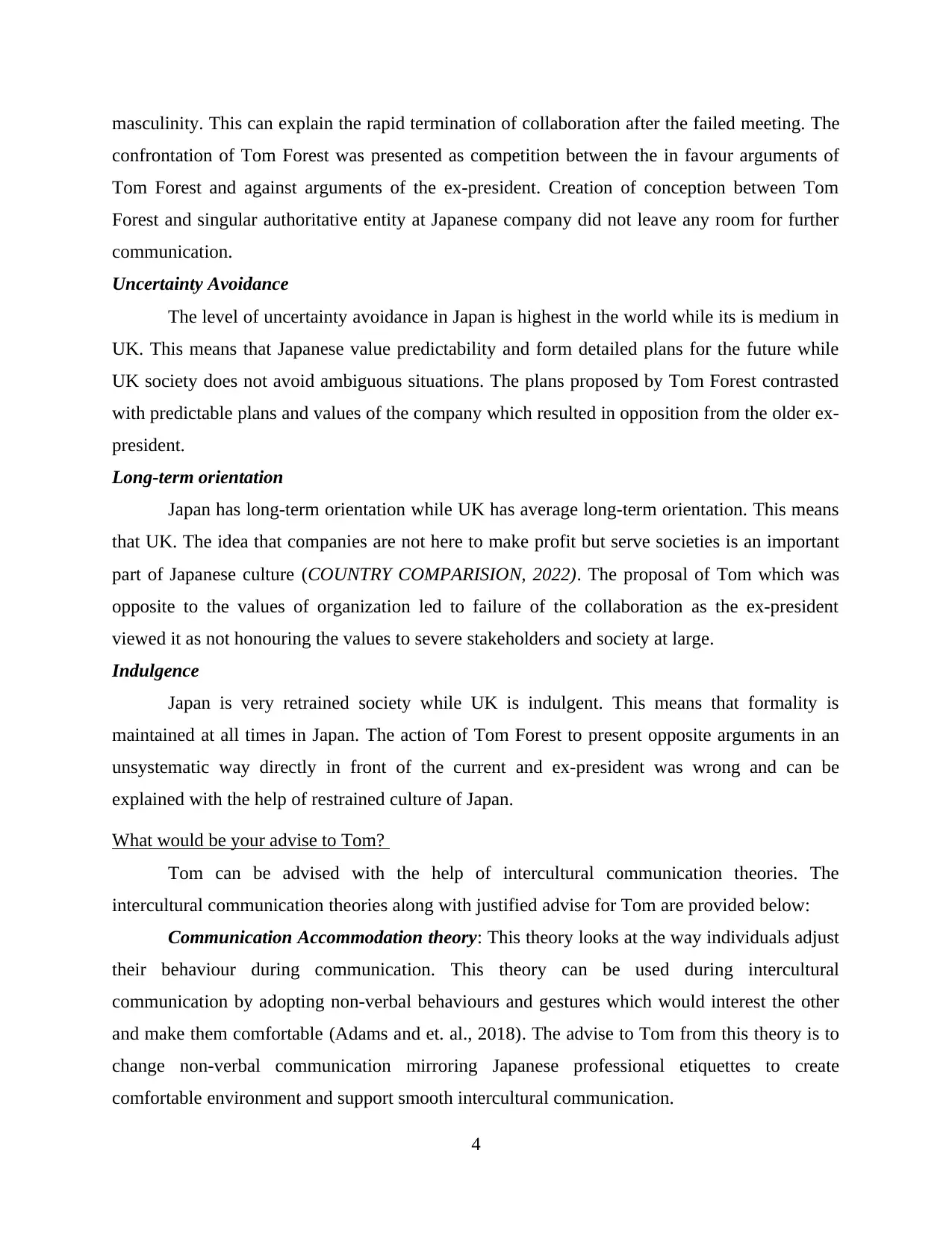
masculinity. This can explain the rapid termination of collaboration after the failed meeting. The
confrontation of Tom Forest was presented as competition between the in favour arguments of
Tom Forest and against arguments of the ex-president. Creation of conception between Tom
Forest and singular authoritative entity at Japanese company did not leave any room for further
communication.
Uncertainty Avoidance
The level of uncertainty avoidance in Japan is highest in the world while its is medium in
UK. This means that Japanese value predictability and form detailed plans for the future while
UK society does not avoid ambiguous situations. The plans proposed by Tom Forest contrasted
with predictable plans and values of the company which resulted in opposition from the older ex-
president.
Long-term orientation
Japan has long-term orientation while UK has average long-term orientation. This means
that UK. The idea that companies are not here to make profit but serve societies is an important
part of Japanese culture (COUNTRY COMPARISION, 2022). The proposal of Tom which was
opposite to the values of organization led to failure of the collaboration as the ex-president
viewed it as not honouring the values to severe stakeholders and society at large.
Indulgence
Japan is very retrained society while UK is indulgent. This means that formality is
maintained at all times in Japan. The action of Tom Forest to present opposite arguments in an
unsystematic way directly in front of the current and ex-president was wrong and can be
explained with the help of restrained culture of Japan.
What would be your advise to Tom?
Tom can be advised with the help of intercultural communication theories. The
intercultural communication theories along with justified advise for Tom are provided below:
Communication Accommodation theory: This theory looks at the way individuals adjust
their behaviour during communication. This theory can be used during intercultural
communication by adopting non-verbal behaviours and gestures which would interest the other
and make them comfortable (Adams and et. al., 2018). The advise to Tom from this theory is to
change non-verbal communication mirroring Japanese professional etiquettes to create
comfortable environment and support smooth intercultural communication.
4
confrontation of Tom Forest was presented as competition between the in favour arguments of
Tom Forest and against arguments of the ex-president. Creation of conception between Tom
Forest and singular authoritative entity at Japanese company did not leave any room for further
communication.
Uncertainty Avoidance
The level of uncertainty avoidance in Japan is highest in the world while its is medium in
UK. This means that Japanese value predictability and form detailed plans for the future while
UK society does not avoid ambiguous situations. The plans proposed by Tom Forest contrasted
with predictable plans and values of the company which resulted in opposition from the older ex-
president.
Long-term orientation
Japan has long-term orientation while UK has average long-term orientation. This means
that UK. The idea that companies are not here to make profit but serve societies is an important
part of Japanese culture (COUNTRY COMPARISION, 2022). The proposal of Tom which was
opposite to the values of organization led to failure of the collaboration as the ex-president
viewed it as not honouring the values to severe stakeholders and society at large.
Indulgence
Japan is very retrained society while UK is indulgent. This means that formality is
maintained at all times in Japan. The action of Tom Forest to present opposite arguments in an
unsystematic way directly in front of the current and ex-president was wrong and can be
explained with the help of restrained culture of Japan.
What would be your advise to Tom?
Tom can be advised with the help of intercultural communication theories. The
intercultural communication theories along with justified advise for Tom are provided below:
Communication Accommodation theory: This theory looks at the way individuals adjust
their behaviour during communication. This theory can be used during intercultural
communication by adopting non-verbal behaviours and gestures which would interest the other
and make them comfortable (Adams and et. al., 2018). The advise to Tom from this theory is to
change non-verbal communication mirroring Japanese professional etiquettes to create
comfortable environment and support smooth intercultural communication.
4
Paraphrase This Document
Need a fresh take? Get an instant paraphrase of this document with our AI Paraphraser
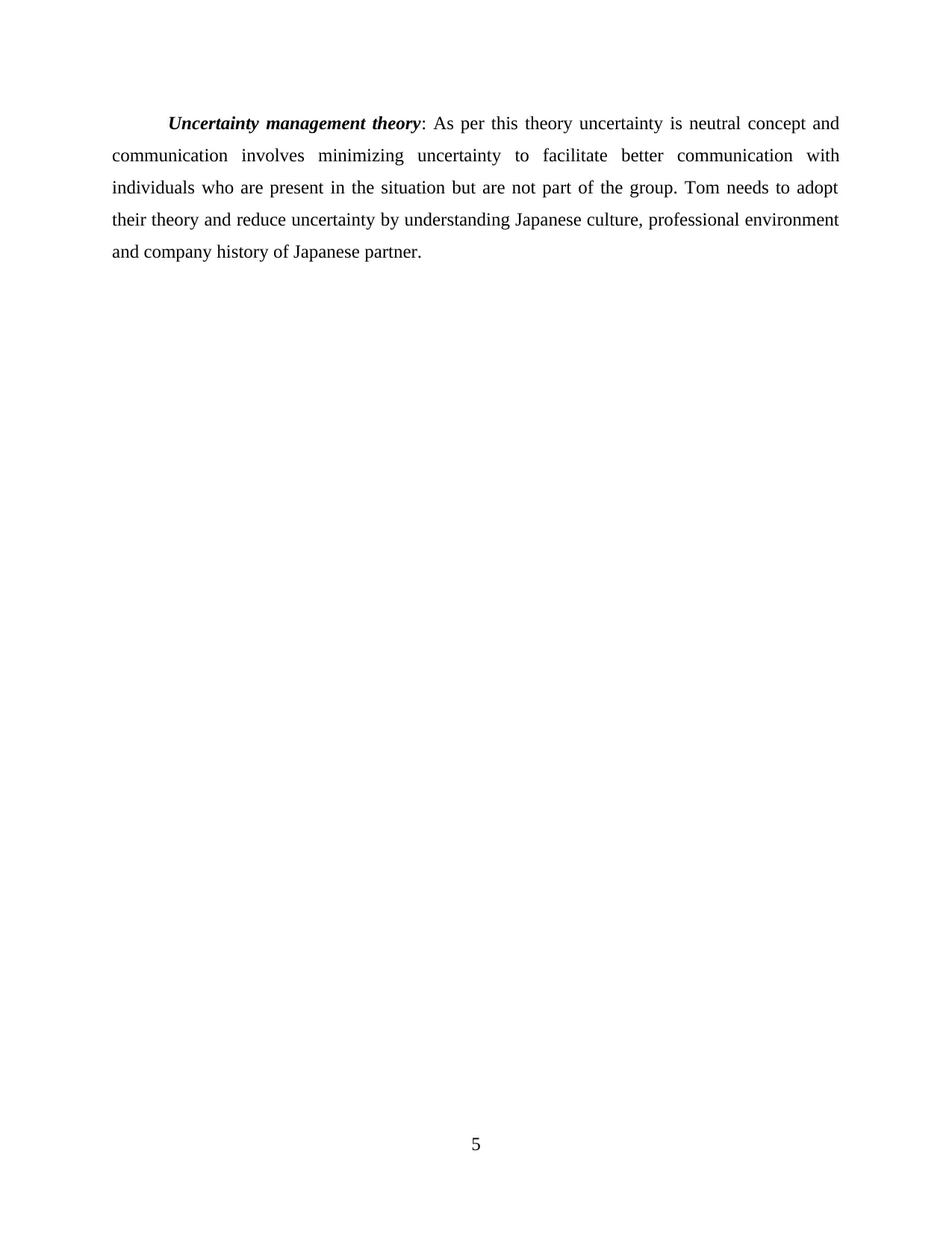
Uncertainty management theory: As per this theory uncertainty is neutral concept and
communication involves minimizing uncertainty to facilitate better communication with
individuals who are present in the situation but are not part of the group. Tom needs to adopt
their theory and reduce uncertainty by understanding Japanese culture, professional environment
and company history of Japanese partner.
5
communication involves minimizing uncertainty to facilitate better communication with
individuals who are present in the situation but are not part of the group. Tom needs to adopt
their theory and reduce uncertainty by understanding Japanese culture, professional environment
and company history of Japanese partner.
5
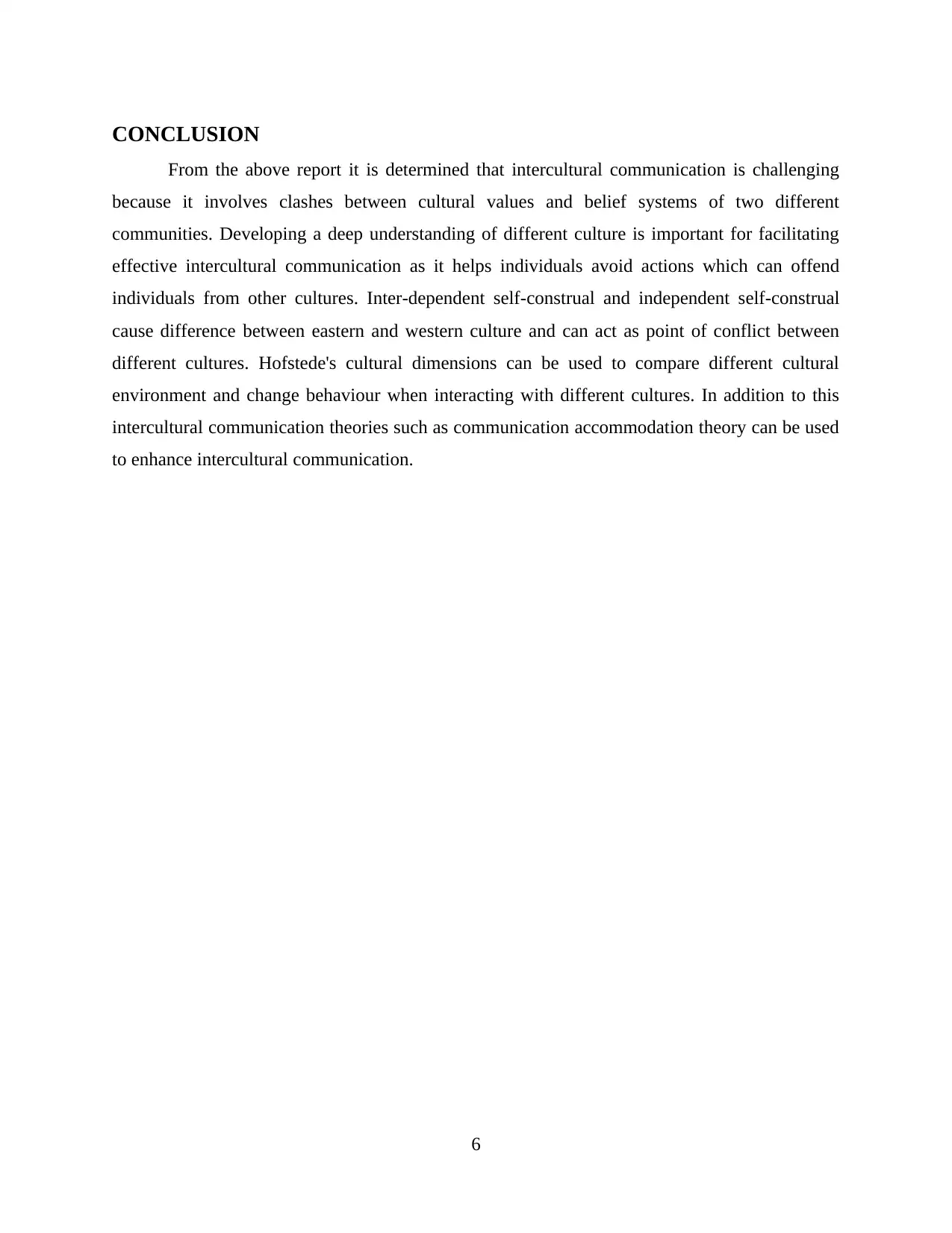
CONCLUSION
From the above report it is determined that intercultural communication is challenging
because it involves clashes between cultural values and belief systems of two different
communities. Developing a deep understanding of different culture is important for facilitating
effective intercultural communication as it helps individuals avoid actions which can offend
individuals from other cultures. Inter-dependent self-construal and independent self-construal
cause difference between eastern and western culture and can act as point of conflict between
different cultures. Hofstede's cultural dimensions can be used to compare different cultural
environment and change behaviour when interacting with different cultures. In addition to this
intercultural communication theories such as communication accommodation theory can be used
to enhance intercultural communication.
6
From the above report it is determined that intercultural communication is challenging
because it involves clashes between cultural values and belief systems of two different
communities. Developing a deep understanding of different culture is important for facilitating
effective intercultural communication as it helps individuals avoid actions which can offend
individuals from other cultures. Inter-dependent self-construal and independent self-construal
cause difference between eastern and western culture and can act as point of conflict between
different cultures. Hofstede's cultural dimensions can be used to compare different cultural
environment and change behaviour when interacting with different cultures. In addition to this
intercultural communication theories such as communication accommodation theory can be used
to enhance intercultural communication.
6
⊘ This is a preview!⊘
Do you want full access?
Subscribe today to unlock all pages.

Trusted by 1+ million students worldwide
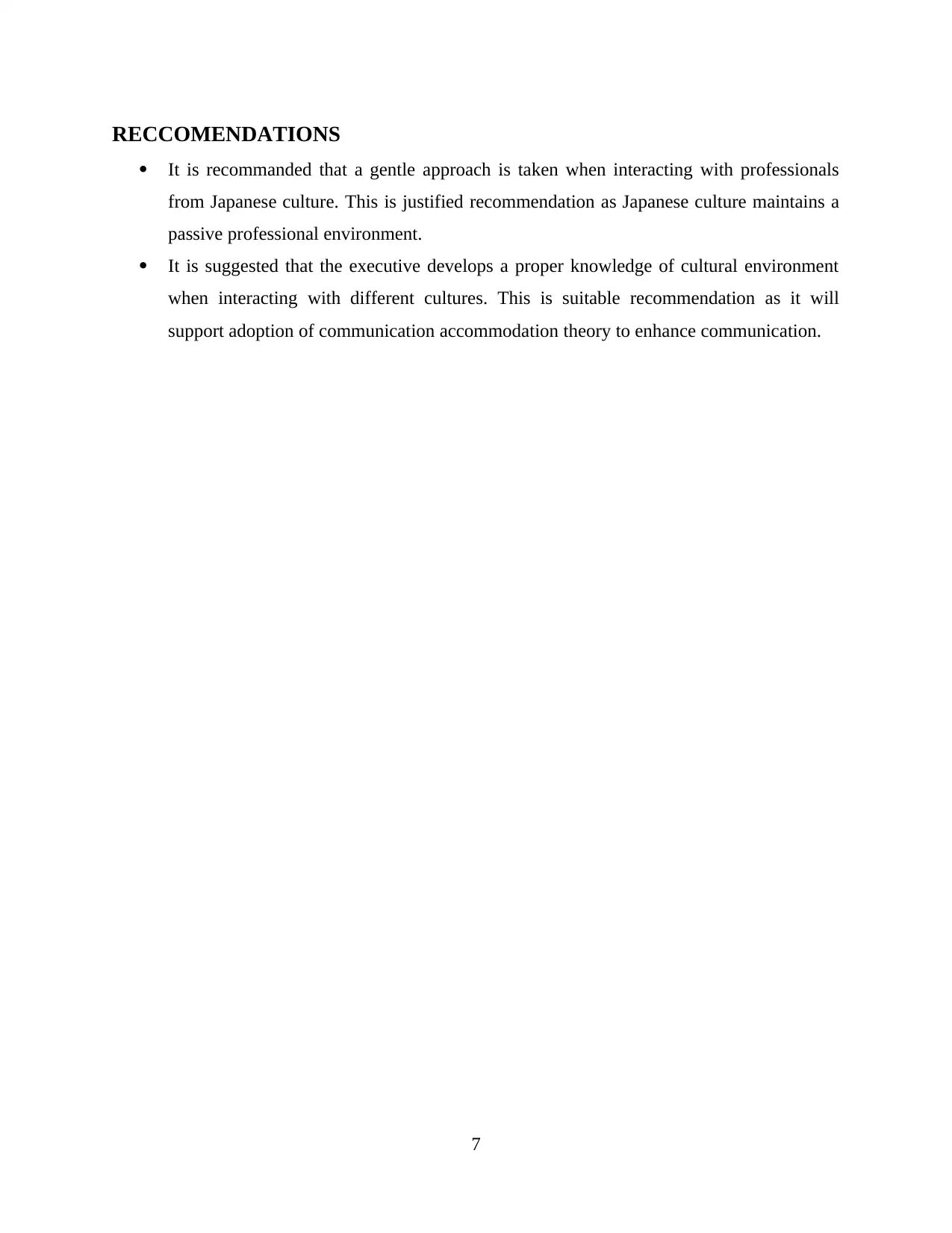
RECCOMENDATIONS
It is recommanded that a gentle approach is taken when interacting with professionals
from Japanese culture. This is justified recommendation as Japanese culture maintains a
passive professional environment.
It is suggested that the executive develops a proper knowledge of cultural environment
when interacting with different cultures. This is suitable recommendation as it will
support adoption of communication accommodation theory to enhance communication.
7
It is recommanded that a gentle approach is taken when interacting with professionals
from Japanese culture. This is justified recommendation as Japanese culture maintains a
passive professional environment.
It is suggested that the executive develops a proper knowledge of cultural environment
when interacting with different cultures. This is suitable recommendation as it will
support adoption of communication accommodation theory to enhance communication.
7
Paraphrase This Document
Need a fresh take? Get an instant paraphrase of this document with our AI Paraphraser
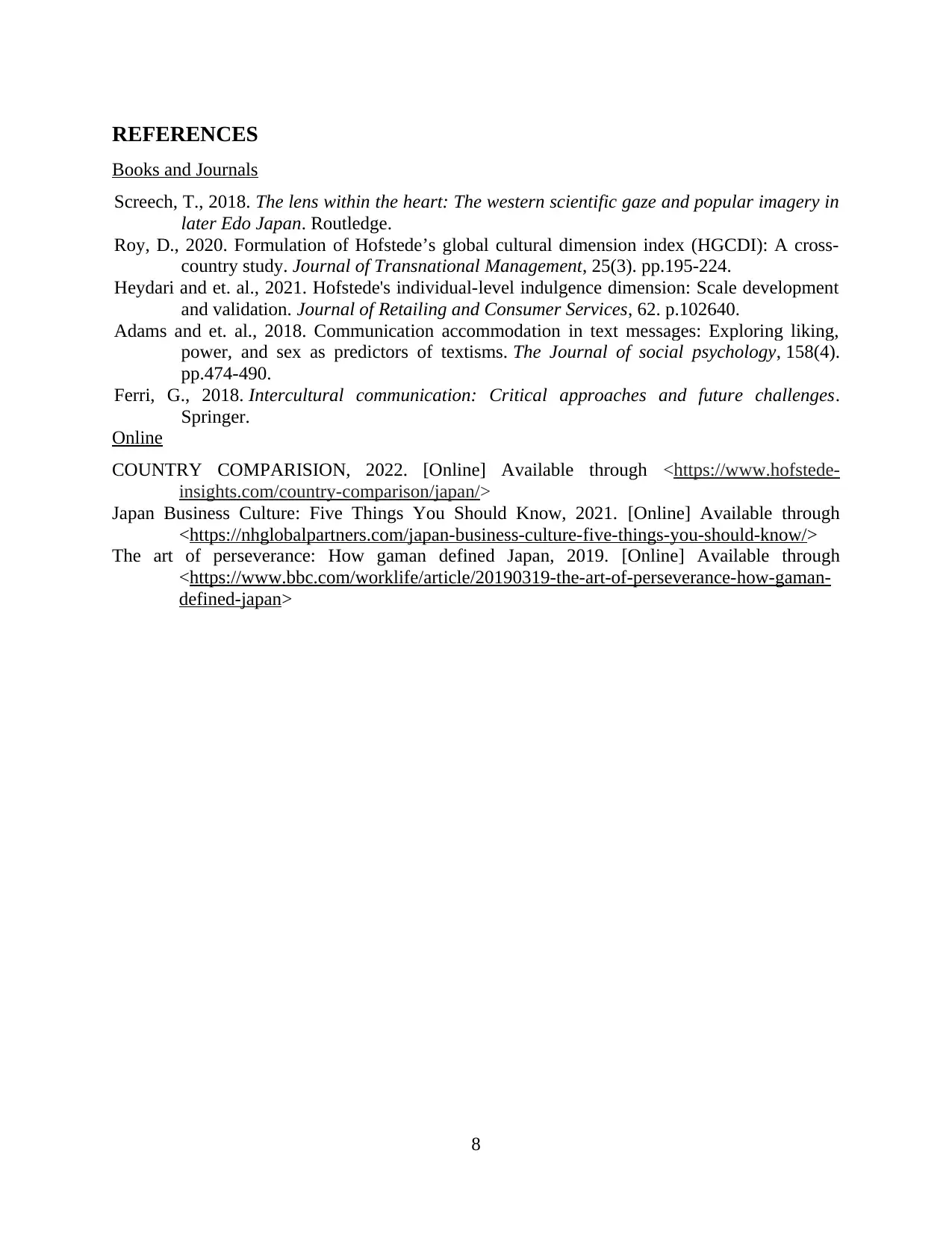
REFERENCES
Books and Journals
Screech, T., 2018. The lens within the heart: The western scientific gaze and popular imagery in
later Edo Japan. Routledge.
Roy, D., 2020. Formulation of Hofstede’s global cultural dimension index (HGCDI): A cross-
country study. Journal of Transnational Management, 25(3). pp.195-224.
Heydari and et. al., 2021. Hofstede's individual-level indulgence dimension: Scale development
and validation. Journal of Retailing and Consumer Services, 62. p.102640.
Adams and et. al., 2018. Communication accommodation in text messages: Exploring liking,
power, and sex as predictors of textisms. The Journal of social psychology, 158(4).
pp.474-490.
Ferri, G., 2018. Intercultural communication: Critical approaches and future challenges.
Springer.
Online
COUNTRY COMPARISION, 2022. [Online] Available through <https://www.hofstede-
insights.com/country-comparison/japan/>
Japan Business Culture: Five Things You Should Know, 2021. [Online] Available through
<https://nhglobalpartners.com/japan-business-culture-five-things-you-should-know/>
The art of perseverance: How gaman defined Japan, 2019. [Online] Available through
<https://www.bbc.com/worklife/article/20190319-the-art-of-perseverance-how-gaman-
defined-japan>
8
Books and Journals
Screech, T., 2018. The lens within the heart: The western scientific gaze and popular imagery in
later Edo Japan. Routledge.
Roy, D., 2020. Formulation of Hofstede’s global cultural dimension index (HGCDI): A cross-
country study. Journal of Transnational Management, 25(3). pp.195-224.
Heydari and et. al., 2021. Hofstede's individual-level indulgence dimension: Scale development
and validation. Journal of Retailing and Consumer Services, 62. p.102640.
Adams and et. al., 2018. Communication accommodation in text messages: Exploring liking,
power, and sex as predictors of textisms. The Journal of social psychology, 158(4).
pp.474-490.
Ferri, G., 2018. Intercultural communication: Critical approaches and future challenges.
Springer.
Online
COUNTRY COMPARISION, 2022. [Online] Available through <https://www.hofstede-
insights.com/country-comparison/japan/>
Japan Business Culture: Five Things You Should Know, 2021. [Online] Available through
<https://nhglobalpartners.com/japan-business-culture-five-things-you-should-know/>
The art of perseverance: How gaman defined Japan, 2019. [Online] Available through
<https://www.bbc.com/worklife/article/20190319-the-art-of-perseverance-how-gaman-
defined-japan>
8
1 out of 11
Related Documents
Your All-in-One AI-Powered Toolkit for Academic Success.
+13062052269
info@desklib.com
Available 24*7 on WhatsApp / Email
![[object Object]](/_next/static/media/star-bottom.7253800d.svg)
Unlock your academic potential
Copyright © 2020–2025 A2Z Services. All Rights Reserved. Developed and managed by ZUCOL.



